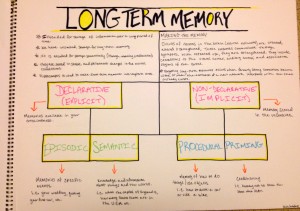Long Term Memory is intended to store information for over a long period of time. We have an unlimited amount of long term memory. These memories are encoded into our brains semantically – based on meaning and association. The process of making the memory consists of circuits of neurons, also known as neural networks, are created, altered, and/or strengthened in this process. These networks communicate through synapses, and with repeated use, these synapses are strengthened. These networks have connections to the visual cortex, auditory cortex, and associative regions of the cortex. These memories are not stored the same way short term memories are stored. Long term memories are stored in more stable and permanent changes in the neural networks spread throughout the brain. Short term memories can become long term memories though. The Hippocampus is used to move short term memories into long term memories. Forgetting, or not being able to recall long term memories occur because a once strong synapse is now weak, or because a new neural network has interfered with the one that already exists. Long Term Memory can be broken down into sub categories called Declarative (Explicit) – memories stored in your consciousness – and Non-Declarative (Implicit) – memories stored in your unconsciousness. Declarative can then be broken down into Episodic memory – the memories of specific events – and Semantic memory – memories of knowledge and information about the world. Likewise, Non-Declarative Memory can be split into Procedural memory – such as how to drive a car or ride a bike – and Priming/Conditioning, which is when you have learned to automatically associate stimuli together. For instance, you know not to touch a hot stove.
